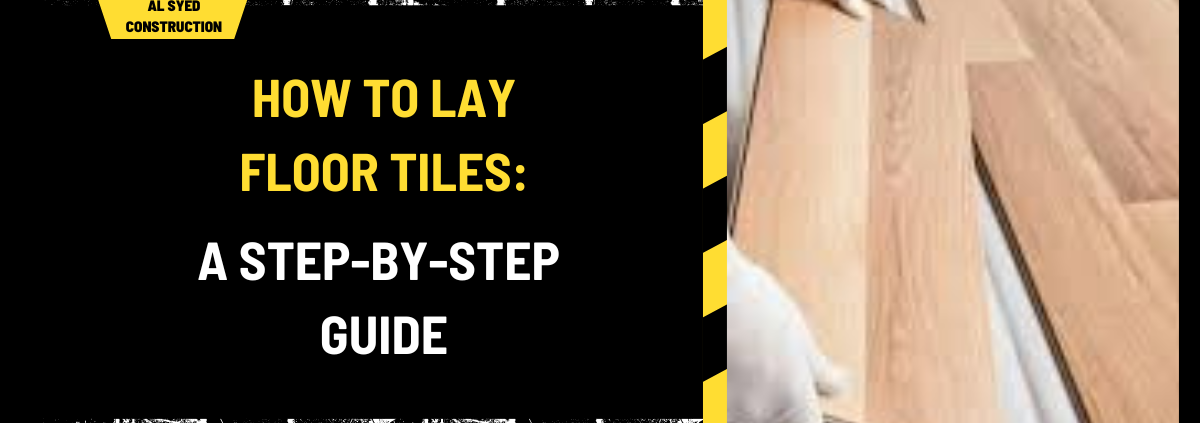How to Lay Floor Tiles: A Step-by-Step Guide
Laying floor tiles is a rewarding home improvement project that can significantly enhance the aesthetic and functional value of your space. Whether you’re updating a kitchen, bathroom, or any other room, understanding the correct techniques and using the right tools is crucial for a successful installation. In this comprehensive guide, we will walk you through the detailed process of laying floor tiles, ensuring a professional and durable finish.
Preparing the Floor for Tile Installation
1. Clean the Subfloor
Before starting, ensure the subfloor is clean and free of debris. Sweep and vacuum the area thoroughly to remove dust and dirt. If the subfloor is particularly dirty or greasy, use a mild detergent and water to clean it. Allow it to dry completely before proceeding.
2. Repair and Level the Subfloor
Inspect the subfloor for any damage or imperfections. Repair any cracks or holes using a suitable filler or patching compound. For a level surface, use a self-leveling underlayment if necessary. An even subfloor is essential for a stable tile installation.
3. Measure and Plan the Layout
Accurate measurement is crucial for a successful tiling job. Measure the dimensions of the room and mark the centerline on the subfloor. This will help you determine the best starting point and ensure that your tiles are evenly aligned. Use a chalk line to mark this centerline and extend it across the entire floor.
Gathering the Necessary Tools and Materials
1. Tile
Select the type of tile suitable for your project. Options include ceramic, porcelain, and natural stone tiles. Ensure you have enough tiles to cover the area, plus an additional 10% for cuts and waste.
2. Thin-Set Mortar
Thin-set mortar is the adhesive used to bond tiles to the subfloor. Choose a high-quality, polymer-modified thin-set mortar for better adhesion and flexibility.
3. Tile Spacers
Tile spacers are essential for maintaining consistent grout lines between tiles. Choose the appropriate size based on the width of your grout joints.
4. Tools
Gather the following tools:
- Notched trowel for applying mortar
- Tile cutter or wet saw for cutting tiles
- Rubber mallet for tapping tiles into place
- Grout float for applying grout
- Level to ensure tiles are aligned
- Bucket and sponge for cleaning grout
Laying the Tiles
1. Apply the Mortar
Start by applying a layer of thin-set mortar to a small section of the floor using the notched trowel. Hold the trowel at a 45-degree angle and spread the mortar evenly. Work in small areas to prevent the mortar from drying out before you lay the tiles.
2. Lay the First Tile
Place the first tile at the intersection of the centerlines. Press the tile firmly into the mortar, ensuring it is level. Use a rubber mallet to tap the tile gently into place. Insert tile spacers between the tiles to maintain even grout lines.
3. Continue Laying Tiles
Proceed by laying the remaining tiles, working from the center towards the edges. Apply mortar to the subfloor in small sections, and place each tile according to your planned layout. Check for levelness frequently and adjust tiles as necessary.
4. Cut Tiles as Needed
When you reach the edges of the room, you may need to cut tiles to fit. Use a tile cutter or wet saw for straight cuts. For more intricate cuts, such as around corners or fixtures, use a tile nipper or angle grinder. Measure carefully and cut tiles to ensure a precise fit.
Grouting the Tiles
1. Allow Mortar to Cure
Before grouting, allow the mortar to cure for at least 24 hours. This will ensure that the tiles are securely bonded to the subfloor.
2. Prepare the Grout
Mix the grout according to the manufacturer’s instructions. Use a grout float to apply the grout over the tiles, pressing it into the joints between the tiles. Work in small sections to ensure the grout doesn’t dry out before you clean it.
3. Remove Excess Grout
After applying grout, use the edge of the grout float to scrape off excess grout from the tile surface. Be careful not to remove grout from the joints. Allow the grout to set for a few minutes before cleaning.
4. Clean the Tiles
Use a damp sponge to clean the tiles, removing any grout haze from the surface. Rinse the sponge frequently and change the water as needed. After the grout has set for the recommended time, use a clean cloth to buff the tiles and remove any remaining haze.
5. Seal the Grout
To protect the grout and enhance its durability, apply a grout sealer once it has fully cured. Follow the manufacturer’s instructions for application and drying times.
Final Steps and Maintenance
1. Inspect the Installation
After the grout has dried, inspect the entire floor for any imperfections. Ensure that all tiles are securely bonded and that grout lines are consistent.
2. Clean and Polish
Give the entire floor a final cleaning to remove any remaining dust or debris. Polish the tiles if necessary to restore their shine and luster.
3. Regular Maintenance
To keep your floor tiles looking their best, regularly clean them with a mild detergent and avoid abrasive cleaners that can damage the surface. Promptly address spills to prevent staining.
Conclusion
Laying floor tiles requires careful preparation, precise cutting, and meticulous application to achieve a professional finish. By following this detailed guide and using the right tools and materials, you can successfully complete your tiling project with confidence.




